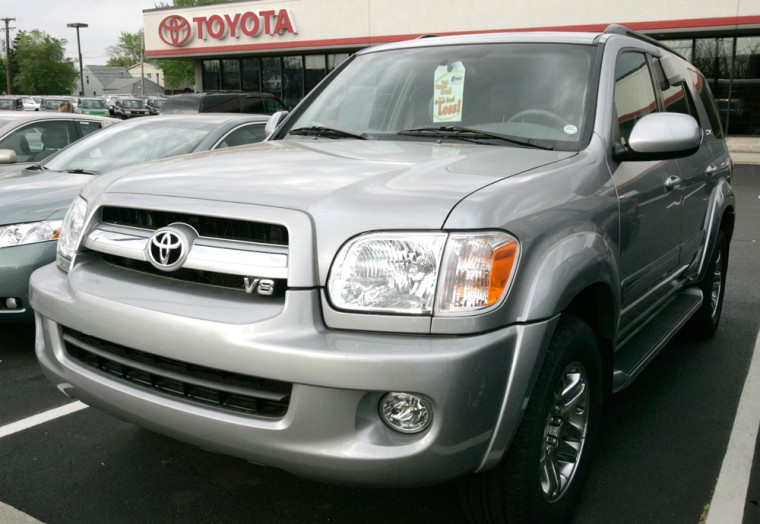Rising gas prices took a toll on the U.S. auto industry in May, flattening sales and causing steep declines for some trucks and sport utilities but giving a boost to Japanese automakers whose new subcompacts hit the market at the right time.
General Motors Corp. said sales were down 12 percent for the month, while Ford Motor Co. reported a 2 percent decline and DaimlerChrysler AG’s Chrysler Group saw sales fall nearly 11 percent.
At the same time, Toyota Motor Corp. and Honda Motor Co. saw double-digit sales increases as consumer demand for more fuel-efficient vehicles grew. Toyota’s overall sales were up 17 percent and car sales were up nearly 25 percent thanks to strong sales of the automaker’s new Yaris subcompact and redesigned Camry sedan. Honda’s sales were up 16 percent and car sales shot up 21 percent as buyers snapped up the Fit subcompact and redesigned Civic sedan.
“It’s Honda’s fuel economy leadership that is driving sales,” Dick Colliver, executive vice president of American Honda Motor Co., said in a news release.
Industrywide sales were flat compared with last May, with trucks and SUVs down 7 percent but cars up 6 percent, according to Autodata Corp. The seasonally adjusted sales rate for May, which shows what total sales would be if they remained at the same rate for the entire year, was 16.1 million vehicles. Automakers sold 17 million vehicles in 2005.
That was a slower sales rate than many on Wall Street expected. In a note to investors, Morgan Stanley analyst Jonathan Steinmetz said investors should take a cautious approach toward auto stocks and warned that weak sales could lead to costly measures such as production cuts or heavy incentive spending.
Paul Ballew, GM’s executive director of market and industry analysis, said automakers felt the full brunt of a spike in gas prices that began in April. Rising interest rates also hurt sales, he said.
But Ballew said GM and other domestic automakers also are fighting the outdated stereotype that their vehicles aren’t fuel efficient. Ballew pointed out that GM offers more vehicles that get 30 miles per gallon than any other automaker.
“That is a story line we have to correct out there in the minds of consumers. By default, Honda and Toyota get credit in consumers’ minds for those attributes,” Ballew said. “Let’s put some facts on the table instead of wishing ill and beating on us and other domestics.”
GM said its car sales fell nearly 16 percent, largely due to cuts in sales to rental car companies. Truck and SUV sales were down 10 percent. Even GM’s new 2007 Chevrolet Tahoe, which has enjoyed a sales boom this spring, was down 5.5 percent in May.
Ballew said comparisons to last year’s sales will continue to be difficult throughout the summer, since GM and other domestics saw near-record sales last year because of its employee discounts.
“We’re not looking at the (new) utilities and wringing our hands,” he said.
Chrysler said its truck and SUV sales fell 14 percent but sales of the 2007 Dodge Caliber, the replacement for the Neon, were strong and helped minimize losses on the car side. Chrysler’s car sales were down 1 percent for the month.
Ford’s SUV sales fell 21 percent, said the automaker’s U.S. sales analysis manager George Pipas. Even sales of the best-selling F-series trucks were down nearly 6 percent for the month. Overall sales of Ford, Lincoln and Mercury trucks and SUVs fell 7 percent.
Pipas said full-size trucks have withstood gas price increases in the past, but the company is watching closely to see what happens this time.
“The commercial demand, the businesses that buy the truck to get the job done, are supporting F-series sales in this environment, but some retail buyers are more cautious and seem to be delaying purchases,” Pipas said.
On the bright side, Ford’s car sales were up nearly 8 percent from last May. Ford said its Fusion midsize sedan posted its best sales month yet with 14,490 vehicles sold, or 18 percent more than April. Ford also said sales of its hybrids have grown 55 percent so far this year, while crossover sales are up 12 percent.
Ford aims to boost U.S. sales with an aggressive incentive plan that began Thursday. Nearly all of the company’s 2006 vehicles are eligible for zero-percent financing and a prepaid debit card that can be used to purchase up to $1,000 worth of gas, or $1,100 for some trucks and sport utility vehicles. The vehicles must be purchased before July 31.
GM Chairman and Chief Executive Rick Wagoner said Thursday that GM is trying to stick with its plan of lowering prices and relying less on incentives, but he acknowledged that could cost the company in the next few months and left open the possibility of matching Ford’s incentives.
“Everybody’s taking their measure of the market and finding out what works for them,” Wagoner said. “We’re trying to operate under a different strategy.”
GM is providing an incentive that caps consumers’ gas prices at $1.99 per gallon, but the program is only running in California and Florida so far. Ballew said GM wanted to test the program regionally before deciding whether to expand it.
Not all Asian brands fared as well as Toyota and Honda. Nissan Motor Co. said its sales were down 7 percent for the month as both cars and trucks saw declines. Nissan’s sales were down 3 percent for the year. Truck and SUV sales took a dive at South Korea’s Hyundai Motor Co., where they fell 34 percent from last May, but car sales were up 26 percent and the automaker’s sales were up 5 percent for the month overall.
The Associated Press reports unadjusted figures, calculating the percentage change in the total number of vehicles sold in one month compared with the same month a year earlier. Some automakers report percentages that are adjusted for the number of sales days in a month.
